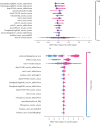Method Matters: Enhancing Voice-Based Depression Detection With a New Data Collection Framework
- PMID: 40444180
- PMCID: PMC12122156
- DOI: 10.1155/da/4839334
Method Matters: Enhancing Voice-Based Depression Detection With a New Data Collection Framework
Abstract
Depression accounts for a major share of global disability-adjusted life-years (DALYs). Diagnosis typically requires a psychiatrist or lengthy self-assessments, which can be challenging for symptomatic individuals. Developing reliable, noninvasive, and accessible detection methods is a healthcare priority. Voice analysis offers a promising approach for early depression detection, potentially improving treatment access and reducing costs. This paper presents a novel pipeline for depression detection that addresses several critical challenges in the field, including data imbalance, label quality, and model generalizability. Our study utilizes a high-quality, high-depression-prevalence dataset collected from a specialized chronic pain clinic, enabling robust depression detection even with a limited sample size. We obtained a lift in the accuracy of up to 15% over the 50-50 baseline in our 52-patient dataset using a 3-fold cross-validation test (which means the train set is n = 34, std 2.8%, p-value 0.01). We further show that combining voice-only acoustic features with a single self-report question (subject unit of distress [SUDs]) significantly improves predictive accuracy. While relying on SUDs is not always good practice, our data collection setting lacked incentives to misrepresent depression status; SUDs were highly reliable, giving 86% accuracy; adding acoustic features raises it to 92%, exceeding the stand-alone potential of SUDs with a p-value 0.1. Further data collection will enhance accuracy, supporting a rapid, noninvasive depression detection method that overcomes clinical barriers. These findings offer a promising tool for early depression detection across clinical settings.
Copyright © 2025 Dan Vilenchik et al. Depression and Anxiety published by John Wiley & Sons Ltd.
Conflict of interest statement
The authors declare no conflicts of interest.
Figures







References
-
- Mitchell A. J., Vaze A., Rao S. Clinical Diagnosis of Depression in Primary Care: A Meta-Analysis. The Lancet . 2009;374(9690):609–619. - PubMed
-
- Hornik-Lurie T., Cwikel J., Zilber N., Feinson M. C., Biderman A., Lerner Y. Does Specializing in Family Medicine Improve the Detection and Diagnosis of Mental Health Problems? The Israel Journal of Psychiatry and Related Sciences . 2016;53(1):63–70. - PubMed
-
- World Health Organization. WHO and ILO Call for New Measures to Tackle Mental Health Issues at Work. 2022. https://www.who.int/news/item/28-09-2022-who-and-ilo-call-for-new-measur... .
MeSH terms
LinkOut - more resources
Full Text Sources
Medical
Research Materials

